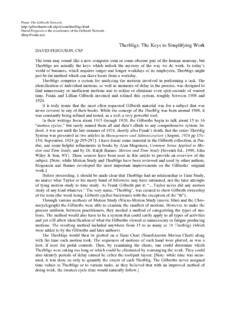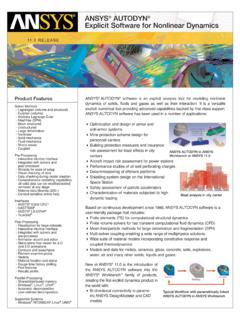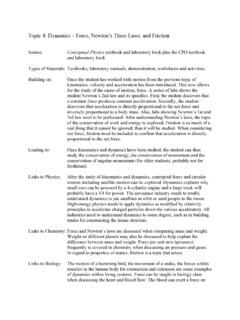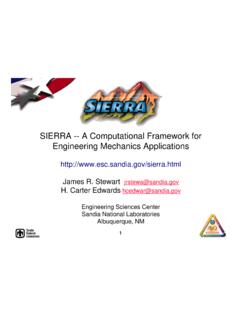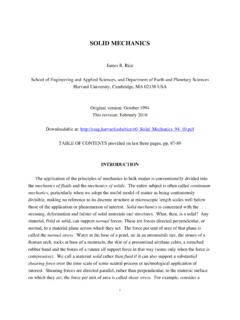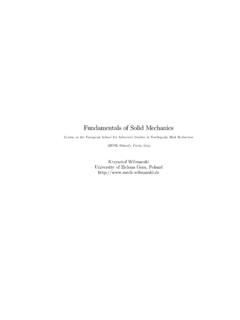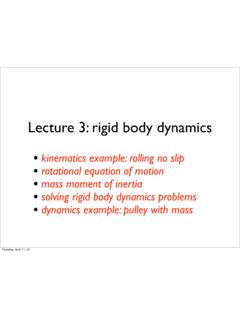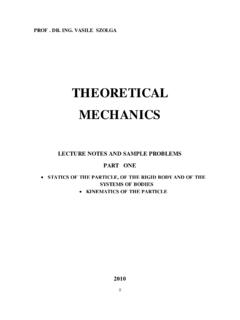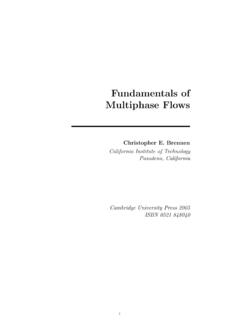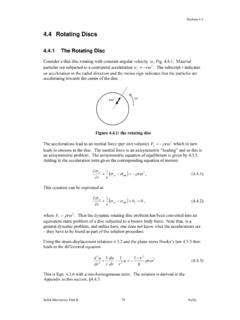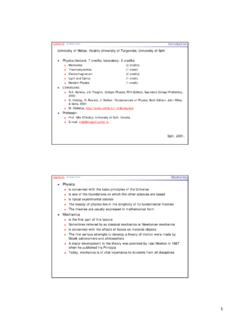Transcription of Chapter 21 Rigid Body Dynamics: Rotation and …
1 Chapter 21 Rigid body dynamics : Rotation and Translation about a Fixed Axis Introduction .. 1 Translational Equation of Motion .. 1 Translational and Rotational Equations of Motion .. 1 Summary .. 6 Translation and Rotation of a Rigid body Undergoing Fixed Axis Rotation . 6 Work-Energy Theorem .. 7 Worked Examples .. 8 Example Angular Impulse .. 8 Example Person on a railroad car moving in a circle .. 9 Example Torque, Rotation and Translation: Yo-Yo .. 13 Example Cylinder Rolling Down Inclined Plane .. 16 Example Bowling Ball .. 21 Example Rotation and Translation Object and Stick Collision.
2 25 21-1 Chapter 21 Rigid body dynamics : Rotation and Translation about a Fixed Axis Accordingly, we find Euler and D'Alembert devoting their talent and their patience to the establishment of the laws of Rotation of the solid bodies. Lagrange has incorporated his own analysis of the problem with his general treatment of mechanics , and since his time M. Poins t has brought the subject under the power of a more searching analysis than that of the calculus, in which ideas take the place of symbols, and intelligent propositions supersede equations. 1 James Clerk Maxwell Introduction We shall analyze the motion of systems of particles and Rigid bodies that are undergoing translational and rotational motion about a fixed direction.
3 Because the body is translating, the axis of Rotation is no longer fixed in space. We shall describe the motion by a translation of the center of mass and a Rotation about the center of mass. By choosing a reference frame moving with the center of mass, we can analyze the rotational motion separately and discover that the torque about the center of mass is equal to the change in the angular momentum about the center of mass. For a Rigid body undergoing fixed axis Rotation about the center of mass, our rotational equation of motion is similar to one we have already encountered for fixed axis Rotation , cmext=d Lcmspin/dt.
4 Translational Equation of Motion We shall think about the system of particles as follows. We treat the whole system as a single point-like particle of mass mT located at the center of mass moving with the velocity of the center of mass Vcm. The external force acting on the system acts at the center of mass and from our earlier result (Eq. ) we have that Fext=d psysdt=ddt(mT Vcm). ( ) Translational and Rotational Equations of Motion For a system of particles, the torque about a point S can be written as 1 J. C. Maxwell on Louis Poins t (1777-1859) in 'On a Dynamical Top' (1857).
5 In W. D. Niven (ed.), The Scientific Papers of James Clerk Maxwell (1890), Vol. 1, 248. 21-2 Sext=( ri Fi)i=1N . ( ) where we have assumed that all internal torques cancel in pairs. Let choose the point S to be the origin of the reference frame O, then rS,cm= Rcm (Figure ). (You may want to recall the main properties of the center of mass reference frame by reviewing Chapter ) Figure Torque diagram for center of mass reference frame We can now apply ri= Rcm+ rcm,i to Eq. ( ) yielding Sext=(( rS,cm+ rcm,i) Fi)i=1N =( rS,cm Fi)i=1N +( rcm,i Fi)i=1N . ( ) The term S,cmext= rS,cm Fext ( ) in Eq.
6 ( ) corresponds to the external torque about the point S where all the external forces act at the center of mass (Figure ). Figure Torque diagram for point-like particle located at center of mass The term, 21-3 cmext=( rcm,i Fi)i=1N . ( ) is the sum of the torques on the individual particles in the center of mass reference frame. If we assume that all internal torques cancel in pairs, then cmext=( rcm,i Fiext)i=1N . ( ) We conclude that the external torque about the point S can be decomposed into two pieces, Sext= S,cmext+ cmext. ( ) We showed in Chapter that LSsys= rS,cm psys+( rcm,i mi vcm,i)i=1N , ( ) where the first term in Eq.
7 ( ) is the orbital angular momentum of the center of mass about the point S LSorbital= rS,cm psys, ( ) and the second term in Eq. ( ) is the spin angular momentum about the center of mass (independent of the point S) LSspin=( rcm,i mi vcm,i)i=1N . ( ) The angular momentum about the point S can therefore be decomposed into two terms LSsys= LSorbital+ LSspin. ( ) Recall that that we have previously shown that it is always true that Sext=d LSsysdt. ( ) Therefore we can therefore substitute Eq. ( ) on the LHS of Eq. ( ) and substitute Eq. ( ) on the RHS of Eq. ( ) yielding as 21-4 S,cmext+ cmext=d LSorbitaldt+d LSspindt.
8 ( ) We shall now show that Eq. ( ) can also be decomposed in two separate conditions. We begin by analyzing the first term on the RHS of Eq. ( ). We differentiate Eq. ( ) and find that d LSorbitaldt=ddt( rS,cm psys). ( ) We apply the vector identity ddt( A B)=d Adt B+ A d Bdt, ( ) to Eq. ( ) yielding d LSorbitaldt=d rS,cmdt psys+ rS,cm d psysdt. ( ) The first term in Eq. ( ) is zero because d rS,cmdt psys= Vcm mtotal Vcm= 0. ( ) Therefore the time derivative of the orbital angular momentum about a point S, Eq. ( ), becomes d LSorbitaldt= rS,cm d psysdt.
9 ( ) In Eq. ( ), the time derivative of the momentum of the system is the external force, Fext=d psysdt. ( ) The expression in Eq. ( ) then becomes the first of our relations d LSorbitaldt= rS,cm Fext= S,cmext. ( ) Thus the time derivative of the orbital angular momentum about the point S is equal to the external torque about the point S where all the external forces act at the center of mass, (we treat the system as a point-like particle located at the center of mass). 21-5 We now consider the second term on the RHS of Eq. ( ), the time derivative of the spin angular momentum about the center of mass.
10 We differentiate Eq. ( ), d LSspindt=ddt( rcm,i mi vcm,i)i=1N . ( ) We again use the product rule for taking the time derivatives of a vector product (Eq. ( )). Then Eq. ( ) the becomes d LSspindt=d rcm,idt mi vcm,i i=1N + rcm,i ddt(mi vcm,i) i=1N . ( ) The first term in Eq. ( ) is zero because d rcm,idt mi vcm,i i=1N =( vcm,i mi vcm,i)i=1N = 0. ( ) Therefore the time derivative of the spin angular momentum about the center of mass, Eq. ( ), becomes d LSspindt= rcm,i ddt(mi vcm,i) i=1N . ( ) The force, acting on an element of mass mi, is Fi=ddt(mi vcm,i).









